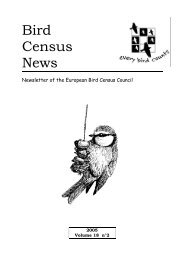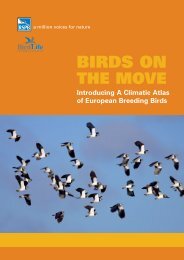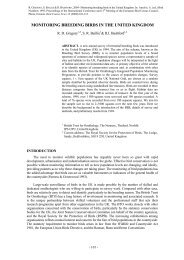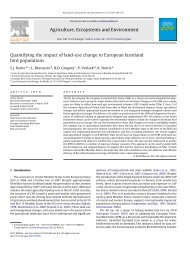<strong>The</strong> <strong>State</strong> <strong>of</strong> Europe’s <strong>Common</strong> <strong><strong>Bird</strong>s</strong> <strong>2008</strong>Photo by D. Boucný (birdphoto.cz)Drainage <strong>of</strong> wetlands and use <strong>of</strong> herbicidesare thought to have caused moderate decline<strong>of</strong> Yellow Wagtail Motacilla flava, a specieswhich prefers moist grassy habitats. It is alsopossible, that this migratory bird suffersincreasing mortality rates during migration,e.g. because <strong>of</strong> environmental degradation<strong>of</strong> the Sahel region.conversion to improved grassland has reducedthe availability <strong>of</strong> wet grassland, one <strong>of</strong> theNorthern Lapwing’s preferred nesting habitats(Taylor and Grant 2004). Increased predation <strong>of</strong>clutches on improved pastures largely accountsfor the reduced breeding success (Baines 1990).productivity and low adult and juvenilesurvivorship (Glutz and Jensen 2007).Attention must also be paid to possiblecompetition with the Eurasian Collared-dove,Streptopelia decaocto, which is expanding inEurope. Drought conditions and habitatdestruction in acacia scrub in the Sahel region,where <strong>European</strong> Turtle-doves spend part <strong>of</strong> theyear, have coincided with the decline in numbers(Jarry 1992). <strong>The</strong> regional differences in thespecies’ trend (see Figure 9) are probably causedby different migration routes and winteringareas <strong>of</strong> the populations and arable landmanagement in different parts <strong>of</strong> Europe.<strong>The</strong> numbers <strong>of</strong> the Northern LapwingVanellus vanellus have decreased all aroundEurope, yet with marked regional differences inthe timing and rate <strong>of</strong> decline (see Figure 10).Intensification <strong>of</strong> grassland systems is believedto be a causal factor in population declines <strong>of</strong>this species, which inhabits open grasslandhabitats and grazed meadows. <strong>The</strong> use <strong>of</strong>chemicals reduces the availability <strong>of</strong>invertebrates, while agricultural machinery andcattle trampling lead to high nest and fledglinglosses (Pakkala et al. 1997). Drainage andThis report also contains information oneleven species for which the data were sufficientto produce reliable <strong>European</strong> trends for the firsttime. Amongst these, the Eurasian Thick-kneeBurhinus oedicnemus has shown a moderateincrease since 1996, albeit with considerablefluctuations. This formerly more widespreadspecies underwent a large decline during 1970–1990 across much <strong>of</strong> Europe, due to habitat lossinduced by human activities (Nipkow 1997).<strong>The</strong> trend <strong>of</strong> this species is based on data fromFrance and Spain, the latter holds more than half<strong>of</strong> the <strong>European</strong> population, and is where thespecies shows some signs <strong>of</strong> recovery.Figure 10 | Regional trends <strong>of</strong> the Northern LapwingVanellus vanellus in Europe. Countries contributing theirdata are grouped as follows: West Europe: Austria,Denmark, former West Germany, Netherlands, UnitedKingdom; South Europe: France, Italy; Central and EastEurope: Czech Republic, Estonia, former East Germany,Hungary, Latvia, Poland; North Europe: Finland, Sweden.10
<strong>The</strong> <strong>State</strong> <strong>of</strong> Europe’s <strong>Common</strong> <strong><strong>Bird</strong>s</strong> <strong>2008</strong><strong>The</strong> Raven Corvus corax is increasing in numbers by around 3% per year. After a long period<strong>of</strong> persecution, the species has experienced a natural recolonisation process, assisted in some placesby reintroduction programmes (Bednorz 1997). While both long- (1980–2006) and short-termtrends (1990–2006) have shown a moderate increase, since 1995 the trend is classified as stable.For regional trends see Figure 11.Photo by T. Pospíšil (birdphoto.cz)Figure 11 | Regional trends <strong>of</strong> the Raven Corvus corax inEurope. Countries contributing their data are groupedas follows: North Europe: Finland, Norway, Sweden; WestEurope: Austria, former West Germany, Netherlands,Switzerland, United Kingdom; South Europe: France,Italy, Portugal, Spain; Central and East Europe: CzechRepublic, Estonia, former East Germany, Hungary,Poland.Among the species that have shown some <strong>of</strong>the greatest increases in Europe between 1980and 2006 is the Great Reed-warbler Acrocephalusarundinaceus, which has increased in abundanceby around 3.5% per year. It seems thatthe population decrease experienced during1970–1990 in many <strong>European</strong> countries hasbeen followed by a recovery, at least in severalcountries holding significant populations.As the population declines were explained by theoverall poor state <strong>of</strong> <strong>European</strong> inland wetlands(drainage, eutrophication, lower arthropoddensities, reduced plant density; Schulze-Hagen1997), we can assume at least some <strong>of</strong> theseparameters have improved.11






